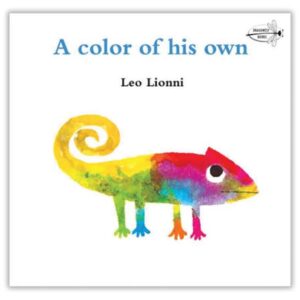Receptive language, Expressive language, Awareness of print and pictures
Toddlers participate in a shared book reading about a chameleon that wants his own color.

A Color of His Own by Leo Lionni


Social-Emotional
[Invite several toddlers to read a book about a chameleon.]
Our book is about a chameleon. A chameleon is a type of lizard that changes colors! Most animals stay the same color. An elephant is always gray. Please think about the types of animals you know. Do they change color or do they stay the same color?
[Encourage toddlers to talk about animals they know staying the same color. Follow-up prompt, if needed: “Does the dog you know ever become a different color?”]
The chameleon in our book wants to stay the same color. He goes looking for a color that can be all his own. Our book tells us about the different colors he sees and who he meets. I think you will like this book!
 [Display book cover. Point to the chameleon.]
[Display book cover. Point to the chameleon.]
Here is the chameleon. He has a lot of colors on his body!
Our book is called A Color of His Own. Let’s find out what happens to the colorful chameleon in our story!
[Open the book. Hold the book close to toddlers. Ask them what they see. Respond positively to toddlers’ reactions to the pictures. Repeat and expand toddlers’ words.]
Our book has pictures and words.
[Point to the words.]
These words say ___.
[Read the first page aloud.
Continue to read and talk about the book using the following strategies to engage toddlers and help them understand how books work:
Vary your voice to add interest.]
The words and pictures in our book told us about a chameleon that wanted a color of his own. He tried to be green, but the leaf changed colors! He was sad and lonely until he met another chameleon. The two chameleons stayed together so they could be the same color. What did the two chameleons feel at the end of the story?
Notice what topics children connect with in this story. Possibilities include colors, how a chameleon changes colors, feelings, and friends. Some children also may notice the use of plurals (one chameleon, two chameleons). Discuss topics of interest to toddlers by asking recall questions about what happened (especially in relation to the chameleon’s color changes) and by labeling things, such as colors on a page.
Extra support
Enrichment
Receptive language, Expressive language, Awareness of print and pictures
Toddlers participate in a shared book reading about a chameleon, followed by individual work with play dough on paper that matches in color.



 Invite several toddlers to read a book about a colorful chameleon. Read the story, emphasizing how the chameleon changes color to match the color of the object he is on. Example: “In this picture the chameleon is red because he is on a red leaf. The color of the chameleon matches the color of the leaf. Both colors are red.” Engage in reading practices suggested in Option 1.
Invite several toddlers to read a book about a colorful chameleon. Read the story, emphasizing how the chameleon changes color to match the color of the object he is on. Example: “In this picture the chameleon is red because he is on a red leaf. The color of the chameleon matches the color of the leaf. Both colors are red.” Engage in reading practices suggested in Option 1.
At the conclusion of the story, give each toddler a sheet of construction paper with a ball of play dough in a matching color on top. Explain the color match. Example: “You have blue play dough on top of blue paper. The color of your play dough and your paper match. They are both blue.” Explain that the sheet of paper is like the leaf in the story. Invite toddlers to create their own reptile or other type of animal with the matching play dough.
Talk with toddlers about their ideas and actions with the play dough. Examples: “Zoe is rolling her play dough. I wonder what she is making with her red play dough?” Describe children’s efforts. Example: “Jeffrey said he is making a dinosaur. Jeffrey is making a yellow dinosaur!”
Play dough is an enjoyable sensory item that supports cognitive and fine motor development. This option combines the sensory experience with a connection to a story. Working with play dough that matches the color of construction paper is intended to support a story theme.
Look for and talk about toddlers’ interests with the play dough. Their work with play dough is an avenue for encouraging talk about plans, interests, and actions. Language development is the goal of this option, not naming colors or creating an animal similar to an illustration in the book.
Extra support
If a toddler finds it particularly challenging to work with play dough, provide other materials, such as crayons and paper.
Enrichment
Invite toddlers to match the color of their construction paper to an item that has a similar or same color in the room. The intent here is to emphasize the concept of matching, not color identification.
Receptive language, Expressive language, Awareness of print and pictures
Toddlers participate in a shared book reading about a chameleon, followed by matching colors of paper.



Be Prepared: Gather sheets of construction paper in shades of green, yellow, and red. Cut additional pieces of construction paper into various shapes, also in shades of green, yellow, and red.
 Invite several toddlers to join you in reading the book A Color of His Own. Read the book, using practices suggested in Option 1. Emphasize the concept of matching, as emphasized in Option 2. In addition to pointing out a match between the color of the chameleon and what the chameleon is sitting on, draw attention to matching color (yellow) of the two chameleons.
Invite several toddlers to join you in reading the book A Color of His Own. Read the book, using practices suggested in Option 1. Emphasize the concept of matching, as emphasized in Option 2. In addition to pointing out a match between the color of the chameleon and what the chameleon is sitting on, draw attention to matching color (yellow) of the two chameleons.
After the story, invite toddlers to select a piece of construction paper and then match the cut pieces of paper to the color of the paper they selected. Emphasize how this is similar to the chameleon matching the color of the leaf in the picture. Example: “You chose green paper, Antonio. Now you can find shapes that match the color of your paper, just like the chameleon in this picture matches the color of the leaf!”
Invite toddlers to glue the matching colored shapes to their construction paper if they wish. Some toddlers may prefer to sort the colors rather than use the glue. Toddlers who enjoy matching one color may want a different-colored sheet of construction paper to match additional colored shapes.
Encourage toddlers to talk about what they are thinking and doing to match colors. Repeat and expand on their comments in ways that support continued participation in the activity. Example: Child picks up a yellow square and says “yellow.” Staff response: Yes, you are holding a yellow square! Do you see any other shapes that are yellow?”
If time permits, invite toddlers to find items in the room that are the same or similar color as their construction paper. Acknowledge and build on matches. Example: “ Wow, you found a red truck! The red truck matches the color of your paper. The red truck also matches the color of your shirt! Do you think you can match the color to anything else in our room?”
Pay attention to and support toddler participation in the matching process. The activity is not intended to be about making a product or identifying a range of colors, but about the task of matching objects of a particular color. Toddlers will differ in their interest in gluing or continuing to find and organize cut pieces of paper on their construction paper. Support the types of participation a toddler pursues. Avoid letting the activity become instruction in gluing. Of central importance to the activity is encouragement of toddler discussion of what they are doing to find matches.
Extra support
Enrichment
Materials Needed: A Color of His Own by Leo Lionni; Brown Bear, Brown Bear, What Do You See? by Bill Martin Jr and Eric Carle; play dough in multiple colors; items to manipulate play dough, such as cookie cutters, plastic knives, and/or molds
Place the books on a low table along with play dough and other items. Review the books and invite toddlers to create their own colorful animals with the play dough. Talk with toddlers about their ideas and what they are doing with the play dough.
Materials Needed: A Color of His Own by Leo Lionni; play dough in multiple colors; and items to manipulate play dough, such as cookie cutters, plastic knives, and/or molds
This book may be shared with all young children in your setting. Play dough is also enjoyed by both older and younger children. Babies may enjoy holding a chunky animal during the story. After the book reading, invite toddlers and older children to create with the play dough. Older children may enjoy sharing play dough ideas and techniques with toddlers.